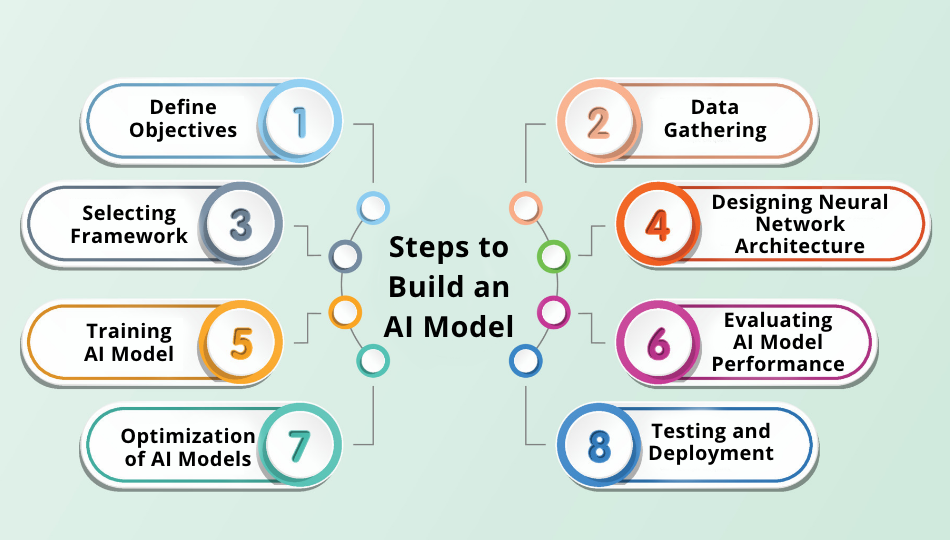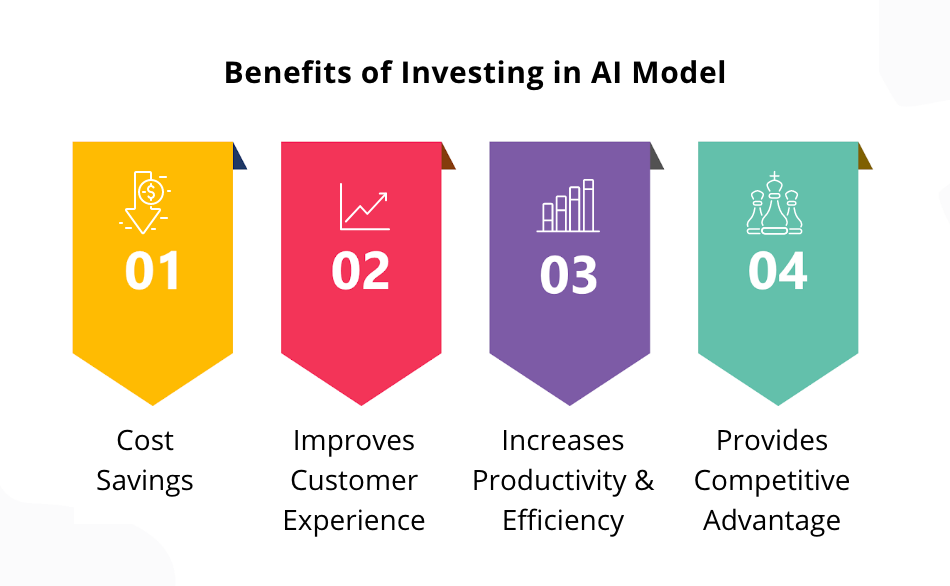Businesses opt to build an AI model to analyze vast amounts of data that help make important decisions without human intervention.
Updated 11 April 2024

CEO at Appventurez
Artificial intelligence has revolutionized various industries and has become a sought-after skill in today’s technology-driven world. From education to entertainment, almost every sector is leveraging the benefits of artificial intelligence to revolutionize their business processes further.
AI can be a game-changer for businesses as it can analyze vast data sets, automate complex processes, and provide valuable insights that drive informed decision-making.
But the question remains how exactly can entrepreneurs harness the power of artificial intelligence development services? The answer lies in building innovative AI models that are tailored to your business needs.
In this blog, we will further delve into the world of intelligent artificial intelligence models, how they benefit businesses, and understand the process to build an AI model that is specifically tailored to entrepreneurs and business leaders.
The AI model is a computer program that analyzes the data to make predictions. For the model to work effectively, it must be fed data and trained to recognize the patterns and the relationships. These unique AI models can predict outcomes in almost any situation across the industry.
The primary objective for which the business opts to build an AI model is to perform complex analyses, further enabling them to make data-driven, informed decisions and predictions in real-time.
At the core of AI models are the super-smart computer programs whose algorithms serve as the intellectual engines that drive the models, enabling them to shift through colossal volumes of data with remarkable efficiency and precision.
Notably, to understand further what is an AI model, it is important to comprehend that these models are equipped with a diverse arsenal of technologies, including:
AI models are grounded in the principles of machine learning development services, a branch of artificial intelligence that empowers the computer to learn from data. Through the iterative processes, they define their understanding of data and work towards improving their ability to make accurate predictions and decisions.
In the language and text-based data, the AI models leverage advanced NLP solutions to decipher the human language, extract semantic meaning, and generate human-like responses. This technology also empowers them to engage in sophisticated conversations, automate customer support, and process unstructured textual data with remarkable accuracy.
AI models often harness the power of neural networks, which are inspired by the structure and function of the human brain. Neural networks, integrated to build an AI model, consist of interconnected nodes that process the information hierarchically and parallelly. This architecture also enables them to handle intricate data relationships.
Before diving into the process to build an AI model, it is significant to understand the phenomenal growth of the global AI market and how it represents a remarkable trajectory in business and technology.
As per the report, by 2030, the market of artificial intelligence, which is currently estimated to be worth around $100 billion, is expected to grow and will be close to $2 trillion.

Several factors are responsible for this remarkable ascent within the artificial intelligence sector. Some of them are:
The steps to build an AI model that caters to your business needs and addresses the challenges faced by your enterprise are mentioned below:

Before starting with the AI model creation, it is crucial to define your objective clearly. It is important to determine what problem you want your AI model to solve or what task it wants you to perform. This clarity will guide you throughout the process.
The quantity and quality of data used for training your AI model significantly impact its performance.
To build an AI model, it is important to collect relevant data that is related to your objective and preprocess it to remove outliers, noises, and inconsistencies. Data preprocessing involves tasks such as cleaning, normalization, and splitting into training or testing sets.
While delving into the process to build an AI model, choosing the right framework is essential as it provides the necessary tools and libraries for building the AI models.
Popular frameworks such as TensorFlow, PyTorch, and Keras offer ample resources, community support, and flexibility. It is important to follow the latest AI trends and select a framework based on your familiarity, requirements, and the ecosystem surrounding it.
Neural networks are at the core of most AI models. Designing an architecture, during the process to build an AI model, involves determining the number of layers, connection patterns, types of neurons, and activation functions.
Before designing the neural network architecture, consider the complexity of your problem and explore different architectures to find the one that maximizes the problems.
Training an AI model involves feeding the prepared data into the network and allowing it to learn from the patterns present.
This process to build an AI model requires defining appropriate loss functions, optimizer algorithms, and training parameters. Monitor the training process and iterate if necessary to improve the performance.
Once the AI model is trained, it becomes crucial to evaluate its performance. Metrics such as precision, accuracy, recall, and F1 score can be used depending on the nature of your problem. Adjustments can also be made in the architecture or the training processes based on the evaluation results.
To improve the performance of the AI model, optimization techniques such as dropout, regularization, and batch normalization can be applied. Additionally, fine-tuning specific hyper-parameters such as learning rate, batch size, or network depth can help achieve better results.
The last stage to build an AI model includes testing the model on independent data that helps verify its generalizability and ensures that it performs well outside the training set. Once you are satisfied with the results, deploy the AI model in your desired application or system.
As businesses choose to build an AI model, it is important to go through various factors to ensure its success. We have mentioned some of the considerations that impact the process of custom AI model development:
Enterprise AI models require a lot of computing power. To properly manage the training and deployment processes, it is important to invest in scalable infrastructure while creating AI models. Booth scalability and flexibility are the features of cloud-based technologies such as Azure, AWS, and Google Cloud.
Sensitive information is frequently present in the enterprise data. While following the process of creating an AI model, it is important to include strong privacy and security safeguards to protect sensitive data throughout the development of AI models.
Generative AI development services have become one of the important trends as AI technology progresses.
ChatGPT is one of the examples of a generative AI model that can produce text, graphics, and even code. This movement opens up new opportunities for inventive problem-solving, automation, and creating unique content within the businesses.
Different regulations apply to different industries. During the process to build an AI model, you must ensure that it conforms to the applicable industry standards and data protection laws such as HIPAA and GDPR.
Investing to build an AI model offers several opportunities and benefits for modern businesses including startups and large-scale organizations. Let’s go through the top reasons that make AI models worth investing in for enterprises.

AI-powered systems such as virtual assistants, personalized recommendations, and chatbot development services can help boost customer interactions and improve the overall user experience.
AI software is designed to streamline processes, automate rule-based tasks, and optimize resources. By automating repetitive tasks through AI, you can concentrate on other strategic activities in your business.
Advanced AI models and technologies significantly minimized operational costs by streamlining labor-intensive processes and managing resource allocation. Over time, the successful implementation of AI models has led to several financial advantages for large-scale organizations.
Opting to build an AI model provides enterprises an edge over their competitors with cutting-edge innovations. AI software and technologies can enable new product development and business models that bring more opportunities to achieve long-term business growth.
The cost to build an AI model can vary depending on various factors, such as the complexity of the model, the level of customization required, and the resources needed.
To create custom AI model, it is important to consider some ethical considerations. Some of them are mentioned below:
After deciding to build an AI model, it is important to ensure that the data for training your AI model is obtained legally and with consent.
Implement robust security measures to protect sensitive data from breaches or unauthorized access. Encryption and access controls are essential.
While building an AI model, you should keep clear and comprehensive records of your AI model’s development process, including data sources, preprocessing steps, and model architecture.
Businesses should strive to make their AI model’s decisions interpretable. Users should understand why the model made a particular prediction or decision, especially with the increased role of artificial intelligence in banking, healthcare, and other industries.
In some cases, consider setting up an internal or external ethical review board to evaluate the potential impact of your AI model on the system and society. Following this also helps organizations understand their responsibility and the importance of business ethics.
Develop and follow the ethical guidelines and the frameworks for AI development within your organization. It is important to assign roles and responsibilities for ethical oversight.
Give users control over the AI system’s recommendations or decisions that affect them, such as content filtering and or personalized advertising.
To build an AI model, ensure that the users are informed about how their data will be used and for what purposes. Allow the users to opt in or out of the data collection and AI-driven features.
To build an AI model, businesses need to understand their goal and what they aim to offer to their consumers. It is important to set up a proper roadmap for the AI model development to make the entire process seamless and effective.
The expertise offered by Appventurez in developing an AI model emphasizes how significant it is to develop a data-driven culture, define business objectives, and use the right set of AI technologies.
Our skilled experts are proficient in offering advanced solutions for building different AI models that will help your business achieve growth, innovation, and efficiency. Collaborate with us to experience AI’s transformative power to boost productivity, encourage economic growth, and stay at the forefront of innovation.
Q. How to create an AI model?
AI models rely on natural language processing, computer vision, and machine learning to recognize different patterns. AI models also use decision-making algorithms, to learn from their training, collect and review data points, and ultimately apply their learning to achieve their predefined goals.
Q. How do I make my own Generative AI model?
Building a generative AI model includes the following steps- gathering data, processing the data, choosing a generative model architecture, training your generative model, evaluating and fine-tuning the AI model, and deploying your generative model.
Q. How does artificial intelligence impact enterprises?
Artificial intelligence impacts enterprises in different ways such as enhanced customer experience, informed decisions, increased productivity, innovation, and predictive analytics.
Q. How do AI models work for enterprises?
AI models for enterprises help in analyzing various data sets with the use of cutting-edge algorithms, and machine learning. Ensuring accuracy and relevance through ongoing monitoring and feedback, numerous enterprises can benefit from improved processes and innovation.


Elevate your journey and empower your choices with our insightful guidance.

CEO at Appventurez
Ajay Kumar has 15+ years of experience in entrepreneurship, project management, and team handling. He has technical expertise in software development and database management. He currently directs the company’s day-to-day functioning and administration.
You’re just one step away from turning your idea into a global product.
Everything begins with a simple conversation.